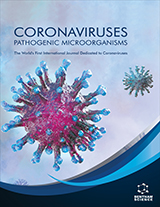Abstract
Background: Rosmarinic acid, a natural compound found in various plants like rosemary and lemon balm, may have potential as a multi-targeted inhibitor for SARS-CoV-2, a strain of virus responsible for COVID-19. SARS-CoV-2, a fusion protein of S1 and S2 subunits, has multiple precursors angiotensin-converting enzyme2 (ACE2), transmembrane serine protease 2 (TMPRSS2), papain-like protease (PLpro), and 3-chymotrypsin-like protease (3CLpro). The chemical interaction of rosmarinic acid with SARS-CoV-2 is of major interest reported here.
Objective: The quantitative study of rosmarinic acid with various precursors of SARS-CoV-2 has been accounted for in detail. Furthermore, the conformational flexibility of rosmarinic acid has also been investigated during the interaction with four different precursors of SARS-CoV-2.
Methods: This investigation delves deeply into the analysis of various aspects, including geometric parameters, atomic charge, the energy gap between the highest occupied and lowest unoccupied molecular orbitals, dipole moments, and the analysis of non-covalent interactions (NCI). Furthermore, the study incorporates molecular docking techniques in conjunction with thorough quantum chemical calculations to provide comprehensive insights.
Results: Rosmarinic acid shows promise as a versatile inhibitor of SARS-CoV-2, the virus responsible for COVID-19. It can target multiple key precursors of the virus, including TMPRSS2, angiotensin- converting enzyme2, 3CLpro, and PLpro, found in the fusion protein comprising S1 and S2 subunits. This study delves into the quantitative analysis of rosmarinic acid's interactions with these precursors. Its adaptable structure allows it to engage with them effectively. Various molecular parameters, including atomic charge, energy gap between molecular orbitals, dipole moment, and noncovalent interactions, are comprehensively explored.
Conclusion: Combining molecular docking and quantum mechanics, the findings suggest rosmarinic acid's potential as a multi-targeted SARS-CoV-2 inhibitor.
Graphical Abstract
[http://dx.doi.org/10.3389/fmed.2021.628370] [PMID: 34950674]
[http://dx.doi.org/10.1016/j.heliyon.2021.e06350] [PMID: 33655086]
[http://dx.doi.org/10.1111/bcpt.13503] [PMID: 33099890]
[http://dx.doi.org/10.1016/S2666-5247(20)30172-5] [PMID: 33521734]
[http://dx.doi.org/10.1016/S0065-3527(06)66005-3] [PMID: 16877062]
[http://dx.doi.org/10.1002/rmv.2106] [PMID: 32302058]
[http://dx.doi.org/10.1056/NEJMoa2001017] [PMID: 31978945]
[http://dx.doi.org/10.1016/S0140-6736(20)30183-5] [PMID: 31986264]
[http://dx.doi.org/10.1016/S0140-6736(20)30211-7] [PMID: 32007143]
[http://dx.doi.org/10.1016/j.febslet.2004.09.009] [PMID: 15474033]
[http://dx.doi.org/10.1016/j.cell.2020.02.052] [PMID: 32142651]
[http://dx.doi.org/10.1016/j.cell.2020.02.058] [PMID: 32155444]
[http://dx.doi.org/10.1016/j.chempr.2020.04.023] [PMID: 32529116]
[http://dx.doi.org/10.1128/JVI.01467-06] [PMID: 17108030]
[http://dx.doi.org/10.18632/oncotarget.8475] [PMID: 27050368]
[http://dx.doi.org/10.1126/science.abb8923] [PMID: 32385100]
[http://dx.doi.org/10.1038/s41467-020-16505-0] [PMID: 32433465]
[http://dx.doi.org/10.1208/s12249-020-01744-7] [PMID: 32761294]
[http://dx.doi.org/10.1271/bbb1961.47.521]
[http://dx.doi.org/10.3390/medicines5030098] [PMID: 30181448]
[http://dx.doi.org/10.3390/cosmetics7040077]
[PMID: 32963731]
[http://dx.doi.org/10.3390/antiox10091439] [PMID: 34573069]
[http://dx.doi.org/10.3389/fnut.2022.924192] [PMID: 35990343]
[http://dx.doi.org/10.1080/10408398.2010.490883] [PMID: 21955093]
[PMID: 10641130]
[http://dx.doi.org/10.1016/S0031-9422(02)00513-7] [PMID: 12482446]
[http://dx.doi.org/10.1017/S1466252317000081] [PMID: 29110743]
[http://dx.doi.org/10.3390/molecules25102271] [PMID: 32408547]
[http://dx.doi.org/10.4155/fmc-2020-0147] [PMID: 32564623]
[http://dx.doi.org/10.2298/JSC220921087K]
[http://dx.doi.org/10.1136/bmjopen-2020-039652] [PMID: 32801208]
[http://dx.doi.org/10.1136/bmjopen-2020-039856] [PMID: 32759252]
[http://dx.doi.org/10.1016/S0140-6736(20)32137-1] [PMID: 33065034]
[http://dx.doi.org/10.1038/s41569-020-0413-9] [PMID: 32690910]
[http://dx.doi.org/10.1038/s41586-020-2798-3] [PMID: 32967006]
[http://dx.doi.org/10.1016/j.ejphar.2020.173759] [PMID: 33249077]
[http://dx.doi.org/10.2174/1573406418666221011093439] [PMID: 36221875]
[http://dx.doi.org/10.1007/s00134-020-05985-9] [PMID: 32125455]
[http://dx.doi.org/10.1016/j.cmi.2020.03.026] [PMID: 32234451]
[http://dx.doi.org/10.1016/j.envres.2020.109819] [PMID: 32569870]
[http://dx.doi.org/10.1080/02786826.2020.1749229] [PMID: 32308568]
[http://dx.doi.org/10.1007/s40200-020-00546-9] [PMID: 32837954]
[http://dx.doi.org/10.1007/s40203-020-00073-8] [PMID: 33432283]
[http://dx.doi.org/10.2174/157340911795677602] [PMID: 21534921]
[http://dx.doi.org/10.1021/jp309167a] [PMID: 23134474]
[http://dx.doi.org/10.1002/jcc.21256] [PMID: 19399780]
[PMID: 10660911]
[http://dx.doi.org/10.1021/jp211366z] [PMID: 22224425]
[http://dx.doi.org/10.1021/jp205894q] [PMID: 21830828]
[http://dx.doi.org/10.1002/wcms.1162]
[http://dx.doi.org/10.1002/jcc.21576] [PMID: 20928852]
[http://dx.doi.org/10.1021/ja100936w]
[http://dx.doi.org/10.1039/b515623h] [PMID: 16633586]
[http://dx.doi.org/10.1021/ct700248k] [PMID: 26620661]
[http://dx.doi.org/10.1063/1.449486]
[http://dx.doi.org/10.26434/chemrxiv.12722072.v1]
[http://dx.doi.org/10.1016/j.solener.2022.12.013]
[http://dx.doi.org/10.1063/1.4820532] [PMID: 24050348]
[http://dx.doi.org/10.1002/chem.201201290] [PMID: 23038653]
[http://dx.doi.org/10.1016/j.saa.2022.122273] [PMID: 36584641]
[http://dx.doi.org/10.1016/j.jphotochem.2023.115084]
[http://dx.doi.org/10.1016/j.molliq.2023.121354]
[http://dx.doi.org/10.1002/cphc.201601405] [PMID: 28124829]
[http://dx.doi.org/10.1039/C3CP54169J] [PMID: 24326976]
[http://dx.doi.org/10.1039/C4CP01693A] [PMID: 25010147]
[http://dx.doi.org/10.1063/1.4748818] [PMID: 22957571]
[http://dx.doi.org/10.1063/1.4706517] [PMID: 22583225]
[http://dx.doi.org/10.1021/jp202658r] [PMID: 21634367]
[http://dx.doi.org/10.1021/acs.jcim.3c00271] [PMID: 37537899]
[http://dx.doi.org/10.1039/D2RA04333E] [PMID: 36128538]
[http://dx.doi.org/10.1021/ct100641a] [PMID: 21516178]




























